The Influence of Power Sources for Charging the Batteries of Electric Cars on CO2 Emissions during Daily Driving: A Case Study from Poland
Abstract
1. Introduction
2. Theoretical Background
2.1. Electric Vehicles
2.2. The Use of EV and Indirect Emissions Associated with the Source of Electricity Production
2.3. Related Works
2.4. Poland as a Case Study
3. Materials and Methods
3.1. Cars Used in the Experiments and Data Collection
3.2. Ecological Analysis
3.3. Sensitivity Analysis
4. Results and Discussion
Energy Mix—Sensitivity Analysis
5. Conclusions
Author Contributions
Funding
Conflicts of Interest
Abbreviations
| BEV | battery electric vehicle |
| EEA | European Environment Agency |
| EU | European Union |
| EV | electric vehicle |
| GHG | greenhouses gases |
| HEV | hybrid electric vehicle |
| ICE | internal combustion engines |
| PHEV | plug-in hybrid electric vehicle |
| REEV | range extended electric vehicle |
| VKT | vehicle kilometers of travel |
References
- Green Paper: A 2030 Framework for Climate and Energy Policies. Available online: http://eur-lex.europa.eu/legal-content/EN/TXT/?uri=CELEX%3A52013DC0169 (accessed on 19 April 2020).
- European Environment Agency (EEA). Total Greenhouse Gas Emission Trends and Projections in Europe; EEA: Copenhagen, Denmark, 2019; Available online: https://www.eea.europa.eu/data-and-maps/ (accessed on 20 April 2020).
- European Environment Agency (EEA). How Have Greenhouse Gas Emissions from Transport in Europe Evolved? EEA: Copenhagen, Denmark, 2019; Available online: https://www.eea.europa.eu/data-and-maps/ (accessed on 20 April 2020).
- Mackett, R. Reducing Car Use in Urban Areas. Transp. Sustain. 2012, 3, 211–230. [Google Scholar]
- EUROSTAT. Passenger Cars in the EU; EUROSTAT: Luxembourg, 2019; Available online: https://ec.europa.eu/eurostat/statistics-explained (accessed on 20 April 2020).
- Frondelius, K.; Oudin, A.; Malmqvist, E. Traffic-Related Air Pollution and Child BMI—A Study of Prenatal Exposure to Nitrogen Oxides and Body Mass Index in Children at the Age of Four Years in Malmö, Sweden. Int. J. Environ. Res. Public Health 2018, 15, 2294. [Google Scholar] [CrossRef] [PubMed]
- Basri, K.; Sahabuddin, E.S.; Tokan, M. Car pollution measurement (a study on ‘health’ environment). Pollut. Res. 2015, 34, 497–502. [Google Scholar]
- Panko, J.; Hitchcock, K.; Fuller, G.; Green, D. Evaluation of Tire Wear Contribution to PM2.5 in Urban Environments. Atmosphere 2019, 10, 99. [Google Scholar] [CrossRef]
- Udaeta, M.E.M.; Chaud, C.A.; Gimenes, A.L.V.; Galvao, L.C.R. Electric Vehicles Analysis inside Electric Mobility Looking for Energy Efficient and Sustainable Metropolis. Open J. Energy Effic. 2015, 4, 1–14. [Google Scholar] [CrossRef][Green Version]
- Thiel, C.; Perujo, A.; Mercier, A. Cost and CO2 aspects of future vehicle options in Europe under new energy policy scenarios. Energy Policy 2010, 38, 7142–7151. [Google Scholar] [CrossRef]
- Van Vliet, O.; Brouwer, A.S.; Kuramochi, T.; Van Den Broek, M.; Faaij, A. Energy use, cost and CO2 emissions of electric cars. J. Power Sour. 2011, 196, 2298–2310. [Google Scholar] [CrossRef]
- Abdul-Manan, A.F.N. Uncertainty and differences in GHG emissions between electric and conventional gasoline vehicles with implications for transport policy making. Energy Policy 2015, 87, 1–7. [Google Scholar] [CrossRef]
- Mahmoudzadeh Andwari, A.; Pesiridis, A.; Rajoo, S.; Martinez-Botas, R.; Esfahanian, V. A review of Battery Electric Vehicle technology and readiness levels. Renew. Sustain. Energy Rev. 2017, 78, 414–430. [Google Scholar] [CrossRef]
- Tran, M.; Banister, D.; Bishop, J.D.K.; McCulloch, M.D. Realizing the electric-vehicle revolution. Nat. Clim. Chang. 2012, 2, 328–333. [Google Scholar] [CrossRef]
- Lévay, P.Z.; Drossinos, Y.; Thiel, C. The effect of fiscal incentives on market penetration of electric vehicles: A pairwise comparison of total cost of ownership. Energy Policy 2017, 105, 524–533. [Google Scholar] [CrossRef]
- Campello-Vicente, H.; Peral-Orts, R.; Campillo-Davo, N.; Velasco-Sanchez, E. The effect of electric vehicleson urban noise maps. Appl. Acoust. 2017, 116, 59–64. [Google Scholar] [CrossRef]
- Figenbaum, E.; Assum, T.; Kolbenstvedt, M. Electromobility in Norway: Experiences and Opportunities. Res. Transp. Econ. 2015, 50, 29–38. [Google Scholar] [CrossRef]
- Ullah, A.; Aimin, W.; Ahmed, M. Smart automation, customer experience and customer engagement inelectric vehicles. Sustainability 2018, 10, 1350. [Google Scholar] [CrossRef]
- Coffman, M.; Bernstein, P.; Wee, S. Electric vehicles revisited: A review of factors that affect adoption. Transp. Rev. 2017, 37, 79–93. [Google Scholar] [CrossRef]
- Franke, T.; Rauh, N.; Günther, M.; Trantow, M.; Krems, J.F. Which Factors Can Protect Against Range Stress inEveryday Usage of Battery Electric Vehicles? Toward Enhancing Sustainability of Electric Mobility Systems. Hum. Factors 2016, 58, 13–26. [Google Scholar] [CrossRef]
- Wang, N.; Tang, L.; Pan, H. A global comparison and assessment of incentive policy on electric vehiclepromotion. Sustain. Cities Soc. 2019, 44, 597–603. [Google Scholar] [CrossRef]
- Turcheniuk, K.; Bondarev, D.; Singhal, V.; Yushin, G. Ten years left to redesign lithium-ion batteries. Nature 2018, 559, 467–470. [Google Scholar] [CrossRef]
- Anthony Jnr, B. Applying Enterprise Architecture for Digital Transformation of Electro Mobility towards Sustainable Transportation. In Proceedings of the 2020 on Computers and People Research Conference, Nuremberg, Germany, 19–21 June 2020; pp. 38–46. [Google Scholar]
- Anthony Jnr, B.; Petersen, S.A.; Ahlers, D.; Krogstie, J. Big Data Driven Multi-Tier Architecture for Electric Mobility as a Service in Smart Cities; Emerald Group Publishing: Bingley, UK, 2020. [Google Scholar] [CrossRef]
- Anthony Jnr, B.; Petersen, S.A. A Practice Based Exploration on Electric Mobility as a Service in Smart Cities. In Proceedings of the European, Mediterranean, and Middle Eastern Conference on Information Systems, Dubai, UAE, 9–10 December 2019; pp. 3–17. [Google Scholar]
- Alexander, M.; Tonachel, L. Projected Greenhouse Gas Emissions for Plug-in Electric Vehicles. World Electr. Veh. J. 2016, 8, 987–995. [Google Scholar] [CrossRef]
- Zhang, Q.; Mclellan, B.C.; Tezuka, T.; Ishihara, K.N. A methodology for economic and environmental analysis of electric vehicles with different operational conditions. Energy 2013, 61, 118–127. [Google Scholar] [CrossRef]
- von Brockdorff, P.; Tanti, G. Carbon Emissions of Plug-in Electric Vehicles in Malta: A Policy Review. Case Stud. Transp. Policy 2017, 5, 509–517. [Google Scholar] [CrossRef]
- Mapou, A.; Shendell, D. Carbon dioxide emissions indirectly generated from U.S. plug-in electric vehicles. In Proceedings of the Climate Change Conference 2013: Impacts, Policy and Regulations, Washington, DC, USA, 9–11 September 2013; pp. 338–342. [Google Scholar]
- Ajanovic, A.; Haas, R. On the Environmental Benignity of Electric Vehicles. J. Sustain. Dev. Energy Water Environ. Syst. 2019, 7, 416–431. [Google Scholar] [CrossRef]
- Hacker, F.; Harthan, R.; Matthes, F.; Zimmer, W. Environmental Impacts and Impact on the Electricity Market of a Large Scale Introduction of Electric Cars in Europe—Critical Review of Literature; ETC/ACC Technical Paper 2009/4; European Topic Centre on Air and Climate Change: Bilthoven, The Netherlands, 2009; p. 169. [Google Scholar]
- Krause, J.; Thiel, C.; Tsokolis, D.; Samaras, Z.; Rota, C.; Ward, A.; Prenniger, P.; Coosemans, T.; Neugebauer, S.; Verhoeve, W. EU road vehicle energy consumption and CO2 emission by 2050—Expert-based scenarios. Energy Policy 2020, 138, 111224. [Google Scholar] [CrossRef]
- EUROSTAT. Energy Balance Sheets 2017 Data; EUROSTAT: Luxembourg, 2019; Available online: https://ec.europa.eu/eurostat/documents (accessed on 20 April 2020).
- Holdway, A.R.; Williams, A.R.; Inderwildi, O.R.; King, D.A. Indirect emissions from electric vehicles: Emissions from electricity generation. Energy Environ. Sci. 2010, 3, 1825–1832. [Google Scholar] [CrossRef]
- Williams, A.R. Electricity, Mobility and the Neglected Indirect Emissions. In Energy, Transport, & the Environment; Springer: London, UK, 2012; pp. 115–134. [Google Scholar]
- Kurien, C.; Srivastava, A.K. Impact of Electric Vehicles on Indirect Carbon Emissions and the Role of Engine Posttreatment Emission Control Strategies. Integr. Environ. Assess. Manag. 2020, 16, 234–244. [Google Scholar] [CrossRef]
- Pan, Y.; Zhang, Y.; Zhang, Z.; Cao, Q. Striving for Synthetic Benefits: Is Your Country Suitable for the Widespread Use of Electric Vehicles. In Proceedings of the International Conference on Management and Service Science, Wuhan, China, 12–14 August 2011. [Google Scholar]
- Wolfram, P.; Wiedmann, T. Electrifying Australian transport: Hybrid life cycle analysis of a transition to electric light-duty vehicles and renewable electricity. Appl. Energy 2017, 206, 531–540. [Google Scholar] [CrossRef]
- Plewa, F.; Strozik, G. Importance of hard coal in electricity generation in Poland. IOP Conf. Ser. Mater. Sci. Eng. 2017, 268, 012001. [Google Scholar] [CrossRef]
- Polish Ministry of Energy (ME). Polityka Energetyczna Polski do 2040 Roku; ME: Warsaw, Poland, 2019.
- Ou, X.; Xiaoyu, Y.; Zhang, X. Life-cycle energy consumption and greenhouse gas emissions for electricity generation and supply in China. Appl. Energy 2011, 88, 289–297. [Google Scholar] [CrossRef]
- Santoyo-Castelazo, E.; Gujba, H.; Azapagic, A. Life cycle assessment of electricity generation in Mexico. Energy 2011, 36, 1488–1499. [Google Scholar] [CrossRef]
- Brizmohun, R.; Ramjeawon, T.; Azapagic, A. Life cycle assessment of electricity generation in mauritius. J. Clean. Prod. 2014, 16, 1727–1734. [Google Scholar] [CrossRef]
- Garcia, R.; Marques, P.; Freire, F. Life-cycle assessment of electricity in Portugal. Appl. Energy 2014, 134, 563–572. [Google Scholar] [CrossRef]
- European Environment Agency (EEA). Air Quality in Europe—2019 Report; EEA: Copenhagen, Denmark, 2019; Available online: https://www.eea.europa.eu/data-and-maps/ (accessed on 15 July 2020).
- Car Info Nordic AB. Report from 25 April 2020. Available online: https://www.car.info/en-se (accessed on 25 April 2020).
- Jamroz, K.; Wachnicka, J. Macro Models of Vehicle Kilometres Travelled. Logist. Transp. 2015, 27, 17–24. [Google Scholar]
- Rentziou, A.; Gkritza, K.; Souleyrette, R. VMT, energy consumption, and GHG emissions forecasting for passenger transportation. Transp. Res. Part A Policy Pract. 2012, 46, 487–500. [Google Scholar] [CrossRef]
- Polish Ministry of Energy (ME). Information No. 34/2017 on the Rules for Determining the CO2 Emission Level for the Purposes of the Auction Support System Referred to in the Provisions of the Act on Renewable Energy Sources; ME: Warsaw, Poland, 2017.
- European Union. Comimission Delegated Regulation (EU) 2015/2402 of 12 October 2015 Reviewing Harmonized Efficiency Reference Values for Separate Production of Electricity and Heat in Application od Directive 2012/27/EU of the European Parliament and of the Council and repealing Commission Implementing Decision 2011/877/EU; European Union: Brussels, Belgium, 2015. [Google Scholar]
- KOBiZE (The National Centre for Emissions Management). CO2, SO2, NOx, CO and Total Dust Emissions Factors for Electricity in 2018; KOBiZE: Warsaw, Poland, 2019. [Google Scholar]
- Ligterink, N.; Eijk, A. Real-World Fuel Consumption of Passenger Cars. In Proceedings of the Transport and Air Pollution Conference, Graz, Austria, 24 September 2014. [Google Scholar]
- Vanderheiden, S. Assessing the case against the SUV. Environ. Politics 2006, 15, 23–40. [Google Scholar] [CrossRef]
- Thiel, C.; Tsakalidis, A.; Jäger-Waldau, A. Will Electric Vehicles Be Killed (again) or Are They the Next Mobility Killer App? Energies 2020, 13, 1828. [Google Scholar] [CrossRef]
- Gelmanova, Z.; Zhabalova, G.; Sivyakova, G.; Lelikova, O.; Onishchenko, O.; Smailova, A.; Kamarova, S. Electric cars. Advantages and disadvantages. J. Phys. Conf. Ser. 2018, 1015, 052029. [Google Scholar] [CrossRef]
- Kolarova, V.; Anderson, J.E.; Hardinghaus, M. Indirect CO2 emissions of electric vehicles: Insights from real-world vehicle use. In Proceedings of the 7th Transport Research Arena TRA 2018, Vienna, Austria, 16–19 April 2018. [Google Scholar]
- McLaren, J.; Miller, J.; O’Shaughnessy, E.; Wood, E.; Shapiro, E. CO2 emissions associated with electric vehicle charging: The impact of electricity generation mix, charging infrastructure availability and vehicle type. Electr. J. 2016, 29, 72–88. [Google Scholar] [CrossRef]
- Jochem, P.; Babrowski, S.; Fichtner, W. Assessing CO2 emissions of electric vehicles in Germany in 2030. Transp. Res. Part A Policy Pract. 2015, 78, 68–83. [Google Scholar] [CrossRef]
- Choi, H.; Shin, J.; Woo, J. Effect of electricity generation mix on battery electric vehicle adoption and its environmental impact. Energy Policy 2018, 121, 13–24. [Google Scholar] [CrossRef]
- IINAS/Öko-Institut e.V, GEMIS 4.94. Emissionsmodell Integrierter Systeme; Software des Öko-Instituts: Freiburg, Germany; IINAS: Darmstadt, Germany, 2015; Report from 15 August 2016; Available online: http://iinas.org/gemis-dokumente.html (accessed on 15 April 2020).
- Abdallah, L.; El-Shennawy, T. Reducing carbon dioxide emissions from electricity sector using smart electric grid applications. J. Eng. 2013, 13, 845051. [Google Scholar] [CrossRef]
- Rievaj, V.; Synák, F. Does electric car produce emissions? Sci. J. Silesian Univ. Technol. Ser. Transp. 2017, 94, 187–197. [Google Scholar] [CrossRef]
- Mann, M.K.; Spath, P.L. The Net CO2 Emissions and Energy Balances of Biomass and Coal-Fired Power Systems. In Proceedings of the Fourth Biomass Conference of the Americas, Oakland, CA, USA, 29 August–2 September 1999; pp. 379–385. [Google Scholar]
- Noussan, M.; Roberta, R.; Nastasi, B. Performance Indicators of Electricity Generation at Country Level—The Case of Italy. Energies 2018, 11, 650. [Google Scholar] [CrossRef]
- Oria, J.; Madariaga, E.; Ortega, A.; Díaz, E.; Mateo, M. Influence of characteristics of marine auxiliary power system in the energy efficiency design index. J. Maritime Transp. Eng. 2015, 4, 67. [Google Scholar]
- Hondo, H. Life cycle GHG emission analysis of power generation systems: Japanese case. Energy 2005, 30, 2042–2056. [Google Scholar] [CrossRef]
- Macuk, R. Transformacja Energetyczna w Polsce Edycja 2020; Forum Energii: Warsaw, Poland, 2020. [Google Scholar]
- Knopf, B.; Bakken, B.; Carrara, S.; Kanudia, A.; Keppo, I.; Koljonen, T.; Mima, S.; Schmid, E.; Vuuren, D. Transforming the European Energy System: Member States’ Prospects within the EU Framework. Clim. Chang. Econ. 2013, 4, 1340005. [Google Scholar] [CrossRef]
- Główny Urząd Statystyczny (GUS). Transport—Wyniki działalności w 2018 roku; GUS: Warsaw, Poland, 2019. [Google Scholar]
- International Council on Clean Transportation (ICOCT). EU CO2 Emission Standards for Passenger Cars and Light-Commercial Vehicles; ICOCT: Washington, DC, USA, 2014; Available online: https://theicct.org/sites/default/files/publications/ (accessed on 11 April 2020).
- Ellingsen, L.A.-W.; Singh, B.; Strømman, A.H. The size and range effect: Lifecycle greenhouse gas emissions of electric vehicles. Environ. Res. Lett. 2016, 11, 054010. [Google Scholar] [CrossRef]
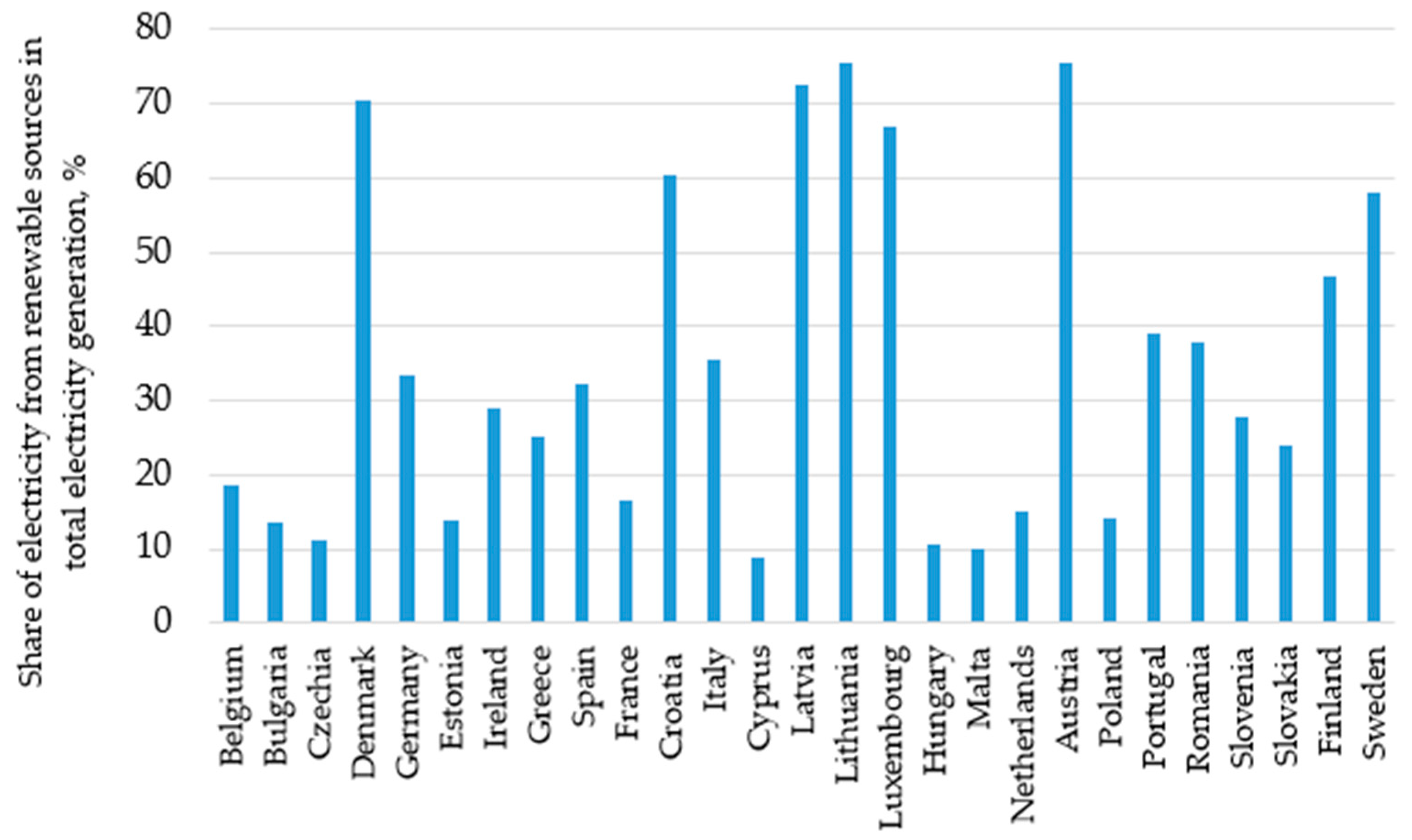

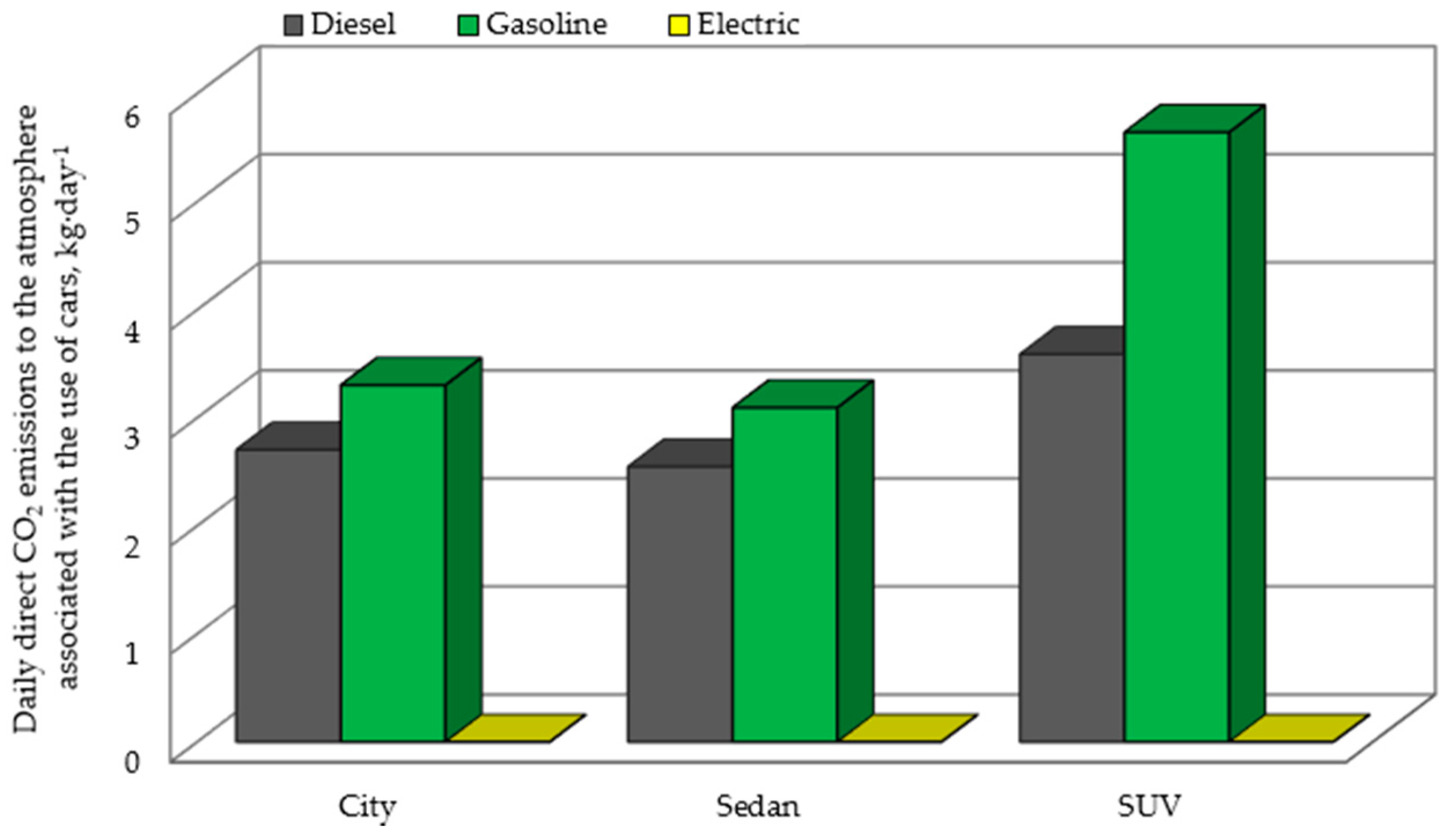
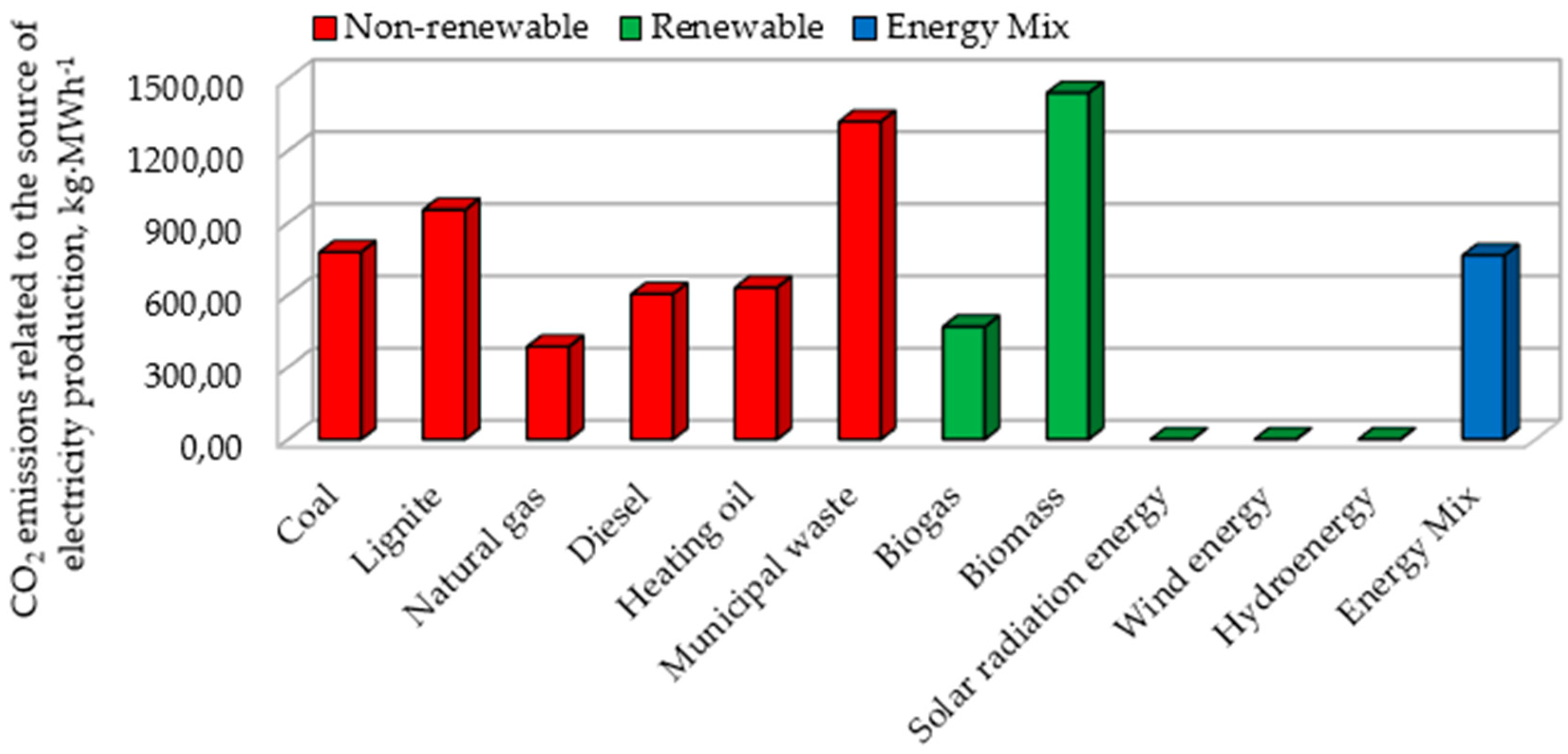
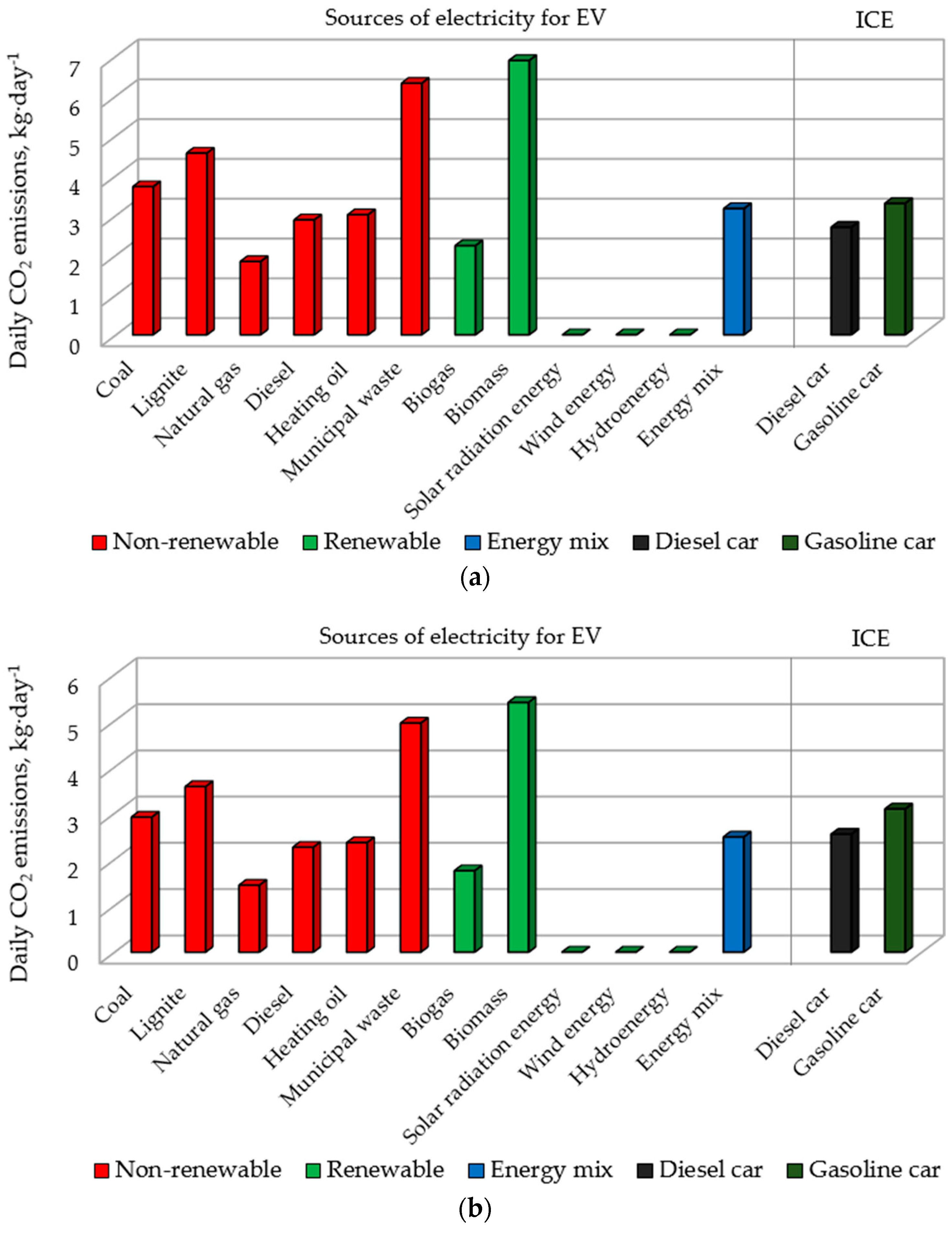
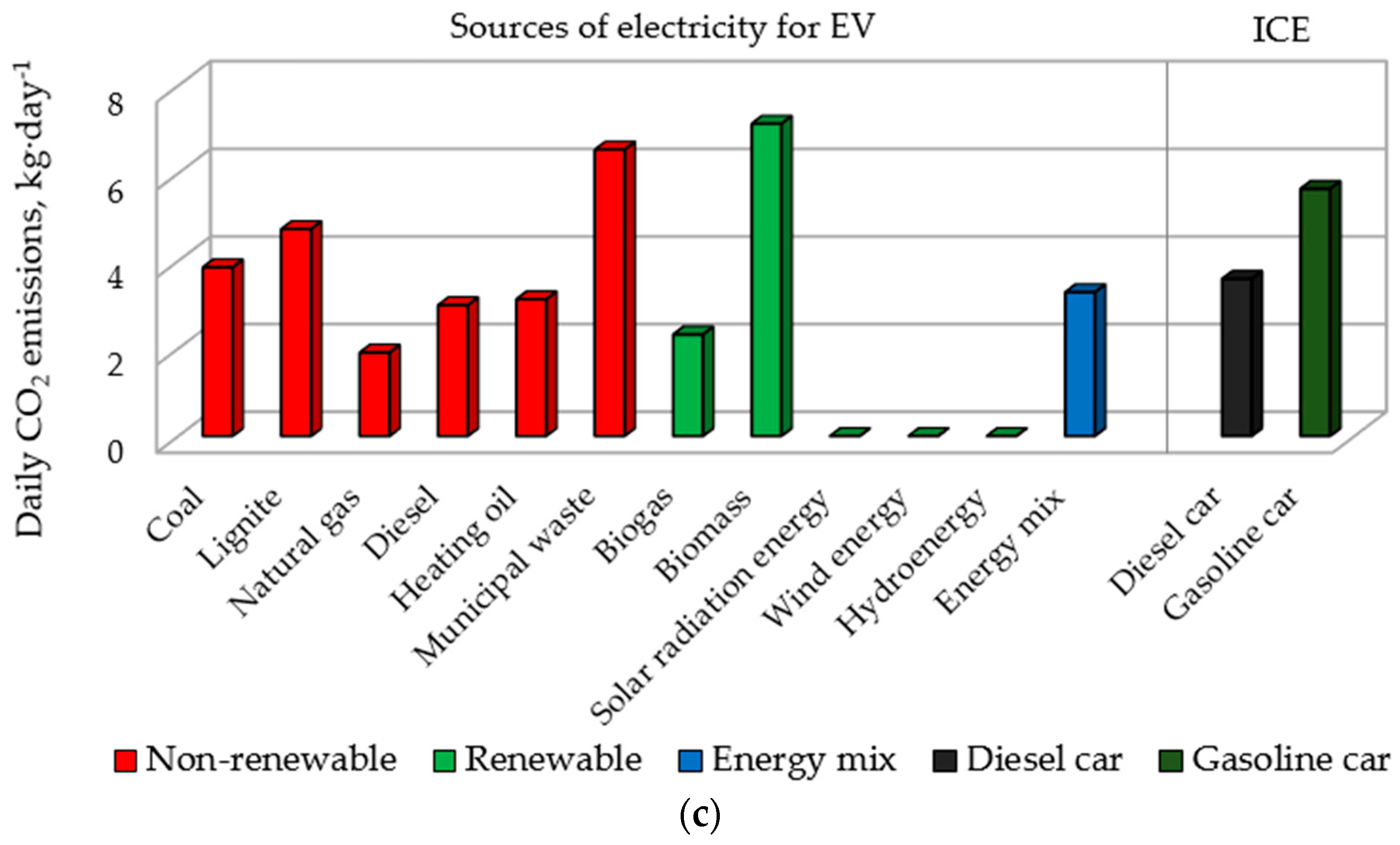
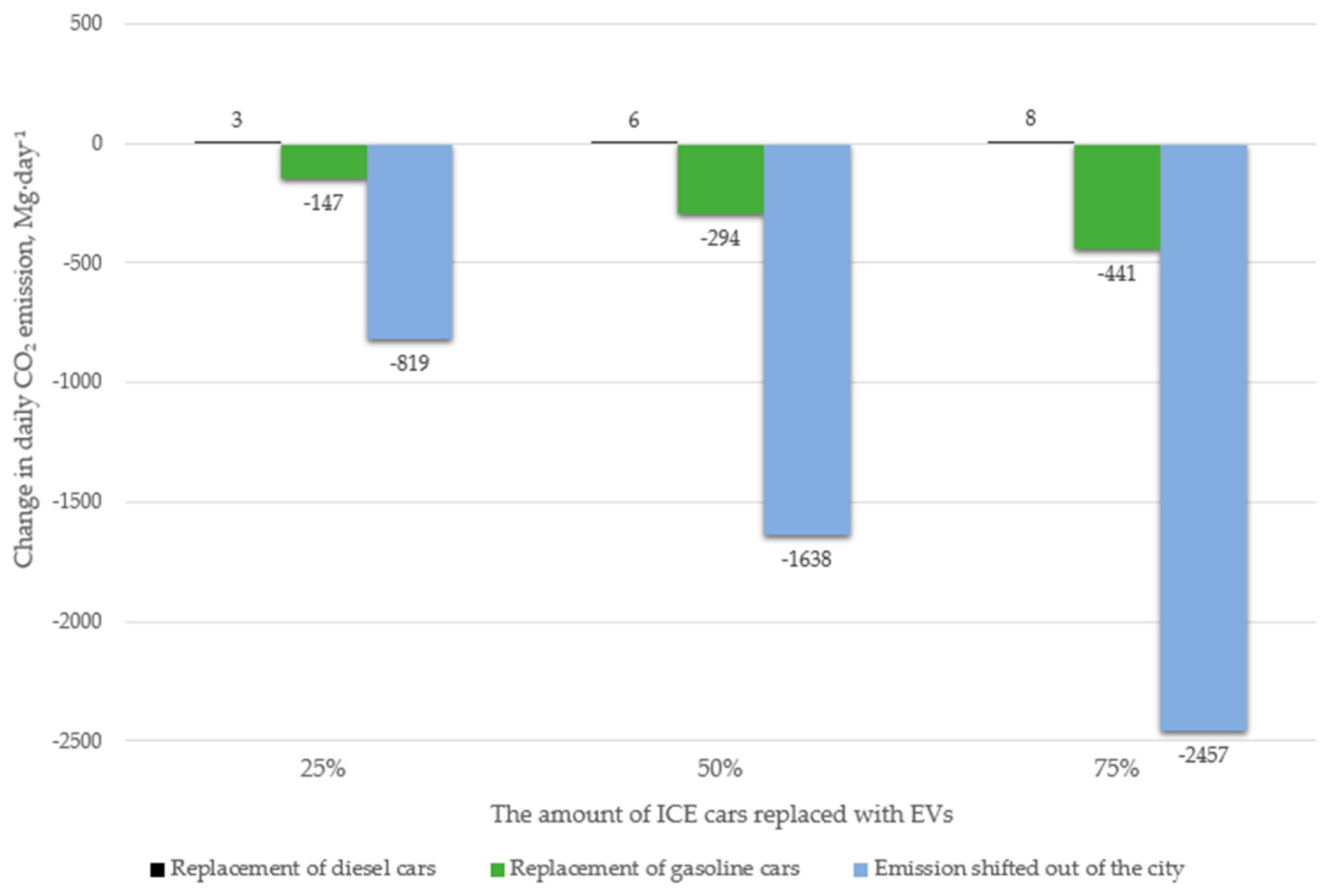
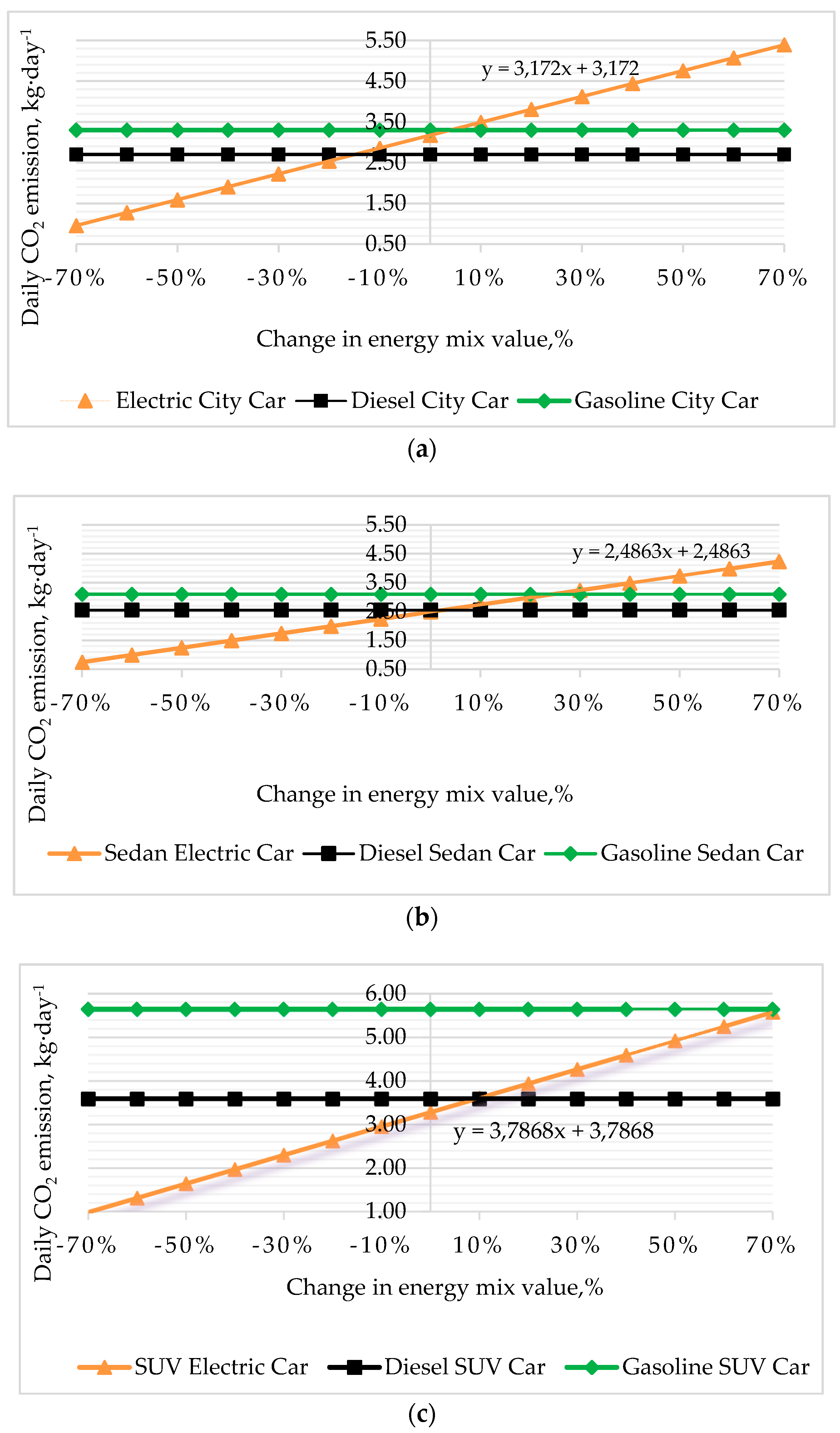
| Authors | Aim | Methodology | Context |
|---|---|---|---|
| Holdway et al. [34] | Analyze indirect CO2 emission related to the source of electricity production and the comparison to direct emissions of the ICE car and Hybrid electric vehicles (HEV). | The average CO2 emissions from electricity generation, Average well-to-wheels CO2 emissions for EV | US, UK and France Case Studies |
| Williams [35] | Analyze indirect CO2 emission related to the source of electricity production and the comparison to direct emissions of the ICE car and Hybrid electric vehicles (HEV). | The average CO2 emissions from electricity generation, Average well-to-wheels CO2 emissions for EV | US, China, Japan, India, Germany, Russia, Brazil, UK, France, Italy, Mexico, South Korea, Spain, Canada, Indonesia Case Studies |
| Kurien and Srivastava [36] | Detailed analysis of the emission threat of EV depending on the scenarios and vehicle category | Average CO2 emissions from EV calculated by referencing the electric power consumed by the vehicle per kilometer and the CO2 emissions during electricity generation | India Case Study |
| Pan et al. [37] | Comprehensive analysis of the widespread use of EVs depending on the electricity sources in a specific country | AGT method | Sweden, US, China, France Case Studies |
| Wolfram and Wiedmann [38] | Analysis of the environmental performance of various types of vehicles in terms of GHG reduction depending on the share of renewable energy sources | LCA method | Australia Case Study |
| Vehicle | Engine Power | Fuel | Curb Weight | Maximum Torque | CO2 Emission | Combined Fuel Consumption | |
|---|---|---|---|---|---|---|---|
| kW | kg | Nm | g∙km−1 | * kWh∙100 km−1 or dm3∙100 km−1 | |||
| City | Mini Cooper D Manual | 80 | Diesel | 1180 | 240 | 104 | 3.9 |
| Kia Rio 1.4 CVVT | 80 | Gasoline | 1165 | 137 | 127 | 5.5 | |
| Renault ZOE R110 41 kWh | 80 | Electricity | 1500 | 225 | 0 | * 15.95 | |
| Sedan | Fiat Tipo Station Wagon 1.6 Multijet Manual | 88 | Diesel | 1395 | 300 | 98 | 3.7 |
| Mazda 3 Sport 2.0 SKYACTIV-G Manual | 88 | Gasoline | 1200 | 210 | 119 | 5.1 | |
| Hyundai Ioniq Electric 28 kWh | 88 | Electricity | 1495 | 295 | 0 | * 12.5 | |
| SUV | Kia Sportage 1.6 CRDi AWD DCT | 100 | Diesel | 1825 | 320 | 138 | 6.4 |
| Chevrolet Captiva 2.4 Manual | 100 | Gasoline | 1665 | 220 | 217 | 8.9 | |
| Peugeot e-2008 | 100 | Electricity | 1548 | 260 | 0 | * 16.5 | |
| Fuel | WeCO2 | η | |
|---|---|---|---|
| kg∙GJ−1 | % | ||
| Non-renewable | Hard coal | 95.48 | 44.2 |
| Lignite | 110.76 | 41.8 | |
| Natural gas | 56.1 | 52.5 | |
| Diesel | 74.1 | 44.2 | |
| Heating oil | 77.4 | 44.2 | |
| Municipal waste | 91.7 | 25.0 | |
| Renewable | Biogas | 54.6 | 42.0 |
| Biomass | 100 | 25.0 | |
| Solar radiation energy | 0 | 30.0 | |
| Wind energy | 0 | 30.0 | |
| Hydro energy | 0 | 30.0 | |
| City | Voivodeship | City Population | Estimated Number of Cars | ||
|---|---|---|---|---|---|
| Diesel | Gasoline | Electric | |||
| Warszawa | Masovia | 1,769,529 | 335,848 | 569,939 | 249 |
© 2020 by the authors. Licensee MDPI, Basel, Switzerland. This article is an open access article distributed under the terms and conditions of the Creative Commons Attribution (CC BY) license (http://creativecommons.org/licenses/by/4.0/).
Share and Cite
Sobol, Ł.; Dyjakon, A. The Influence of Power Sources for Charging the Batteries of Electric Cars on CO2 Emissions during Daily Driving: A Case Study from Poland. Energies 2020, 13, 4267. https://doi.org/10.3390/en13164267
Sobol Ł, Dyjakon A. The Influence of Power Sources for Charging the Batteries of Electric Cars on CO2 Emissions during Daily Driving: A Case Study from Poland. Energies. 2020; 13(16):4267. https://doi.org/10.3390/en13164267
Chicago/Turabian StyleSobol, Łukasz, and Arkadiusz Dyjakon. 2020. "The Influence of Power Sources for Charging the Batteries of Electric Cars on CO2 Emissions during Daily Driving: A Case Study from Poland" Energies 13, no. 16: 4267. https://doi.org/10.3390/en13164267
APA StyleSobol, Ł., & Dyjakon, A. (2020). The Influence of Power Sources for Charging the Batteries of Electric Cars on CO2 Emissions during Daily Driving: A Case Study from Poland. Energies, 13(16), 4267. https://doi.org/10.3390/en13164267







